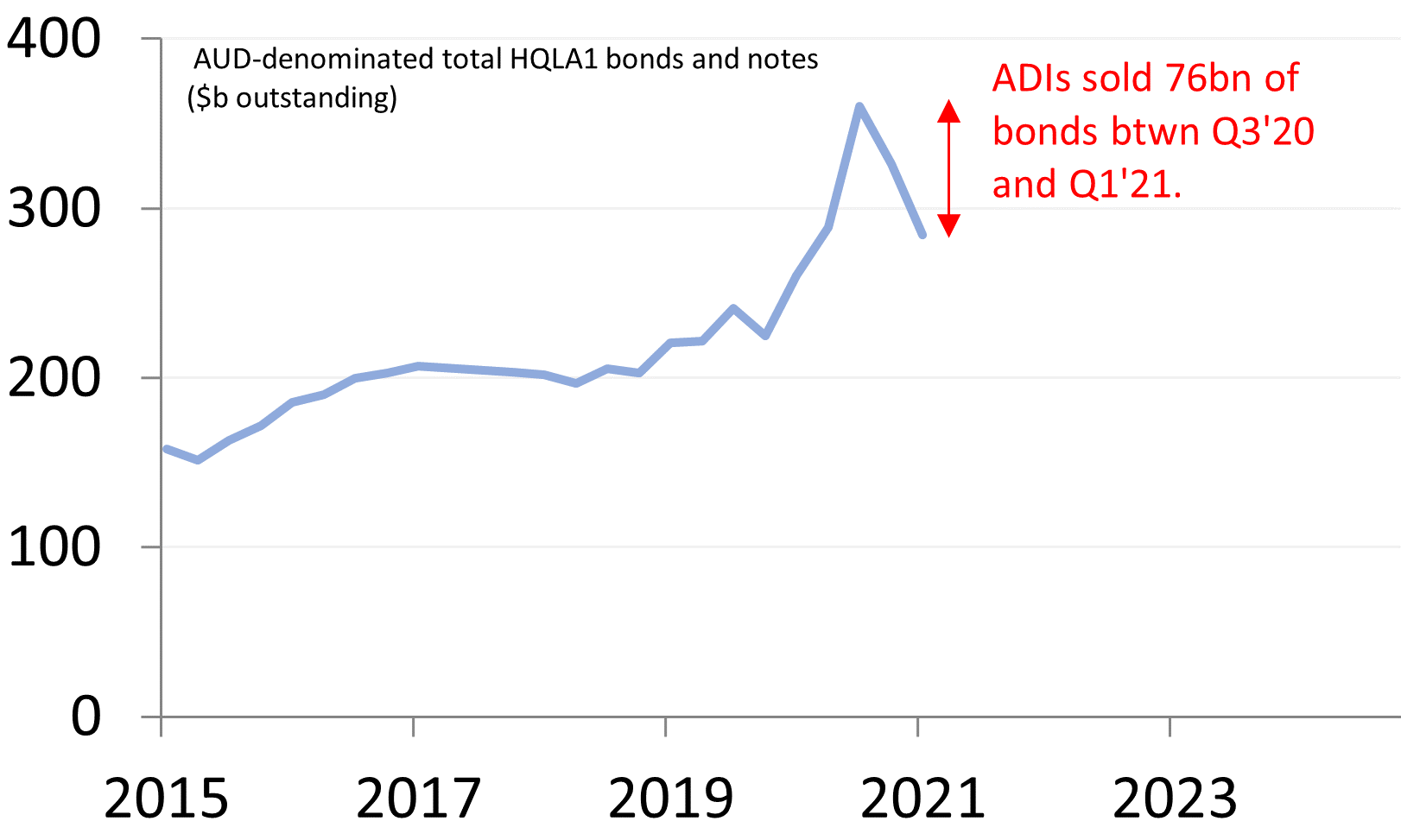Better aligning fiscal, monetary, and bank regulatory policy

Coolabah Capital
The COVID-shock of 2020 put a spotlight on a design flaw in Australian banking regulations. At a time when governments are borrowing lots of money, and the RBA is buying government bonds to boost the economy, regulations discourage banks from owning government bonds. Instead, banks have been selling government bonds, essentially working against monetary policy. This is an undesirable outcome. Regulations ought to be changed to encourage banks to hold more bonds.
In March 2020 households were both unwilling and unable to spend as shops shut and people hunkered down. The massive collapse of spending that resulted from this hunkering down showed up as higher savings and, ultimately, bank deposits. The government borrowed these savings by issuing bonds and spent the money -- to keep the economy going. The RBA supported this fiscal strategy by both lowering interest rates and buying government bonds.
From Q3'20, banks were working in the other direction. Between Q3’20 and Q1’21 (the latest data for which we have data), the RBA purchased $110bn of government bonds via their QE program and banks sold $76bn of government bonds (more precisely Australian Deposit taking institutions subject to the Liquidity Coverage Ratio sold these bonds). So, banks offset about 70% of the RBA’s QE over this period.

If, instead, banks were buying government bonds alongside the RBA, interest rates would be lower, the Australian dollar would be lower, and the economy would be stronger.
More bank buying of government bonds would also support fiscal policy. Lower interest rates make debt more affordable. Australian governments could then choose between spending a bit more (essentially spending the savings from the lower interest rate) or cutting taxes.
Of course, this money doesn’t come ‘out of thin air’. It is a transfer from those who currently invest in Australian government bonds. They would have to accept a lower interest rate. So, it’s essentially a transfer from government bond investors to Australian taxpayers. Around two fifths of government bonds are held by foreigners.
Change would also support fiscal policy by better aligning the demand for bonds with the type of spending governments want to undertake. Even before the COVID-recession, there was a broad consensus that Australia should spend more on infrastructure. The desirability of boosting demand following the crisis has further encouraged this category of spending.
Infrastructure takes a long time to build and lasts a long time. It is prudent to fund long-lived investments with long-dated debt. But the current regulations dissuade banks from buying long dated government bonds (the capital charge is higher for long-dated debt).
Of course, governments could fund the infrastructure by issuing short and managing the 'mismatch' – but managing interest rate ‘mismatch’ risk is the business and skill of banks and bankers. Good public policy should seek to align risks with skills.
The ideal regulations would encourage banks to buy longer-dated debt. Aligning demand with the investment plans of borrowers would transfer interest rate risk to those who want it, or are best placed to manage it.
Current regulations also create a bias toward private transactions over public transactions. For example, if a bank were to make a direct loan to an Australian government to fund infrastructure, it would not have to hold APS117 capital against the loan (assuming that the fixed rate loan is hedged with swap). However, if the same loan were made via the purchase of a government bond on public capital markets, APS117 capital would have to be held against the bond (because of the volatility of the hedge).
This is perverse. A government bond is both a highly liquid asset and subject to all the scrutiny that comes with public capital markets. A direct loan is illiquid, and subject to much less scrutiny. Good public policy should encourage public funding of governments, to encourage transparency and scrutiny. Under the right circumstances, banks should have to hold less capital against bonds, relative to loans, as their superior liquidity and greater scrutiny means bonds are better assets.
At least, we should treat them the same. If we are happy enough with the swap-hedge on a direct loan we should consider if that hedge is good enough for a bond that’s held in a bank's high quality liquid asset (HQLA) book as well.
The main argument, then, is that capital must be held against the possibility that the value of bonds in an HQLA book falls at just the point that they must be sold. After all, bonds in liquid asset portfolios are notionally held so that they can be sold for cash in a crisis.
But this doesn’t stand up to close scrutiny. Banks hold just under $300bn of government bonds just now. Even on the best day, there is no bid for hundreds of billions of dollars of government bonds. And in a crisis we wouldn’t want banks to sell down their enormous liquid asset books. It would destroy the liquidity of the government bond market.
A liquid risk-free benchmark is a public good that should be, and would be, protected.
So, the only buyer of theses bonds is the RBA. In practice, the banks wouldn’t even sell the bonds to the RBA. They would enter into a long-dated agreement to swap the bonds for cash today, with an agreement to reverse the transaction at a later date.
It follows that the only purpose of these HQLA holdings is to make sure the taxpayer gets collateral of the highest quality when they back-stop the banking system (via the RBA). This is a good aim for public policy. The taxpayer, via regulation, requires banks to invest some of their portfolio into high-quality government bonds. These government bond holdings are the price of the government-backstop in a crisis.
It also follows that the government bonds banks hold in these portfolios can be treated differently.
Some capital should be held against the risk in these portfolios – to prevent banks from filling them up with the riskiest government bonds. However, there are better policy designs that the current statistical approach, based on the historical volatility of these bonds. A risk measurement approach based on the (normalised) level of the spread between the bond and the hedge would make more sense.
Consider what happened in March 2020. A once-in-one hundred year pandemic caused a liquidity shock. That liquidity shock caused very sharp moves in government bond markets, and in particular the spreads between bond and swap rates (swaps are the hedge). To protect the integrity of the government bond market, central banks all around the world started buying government bonds to stabilize government markets. The vigour of this response fully reversed the widening of spreads between government bonds and swaps.
The way APRA currently measures risk, that short period of volatility, that was actively reversed by the RBA, has led to a large increase in the cost (capital charge) for holding government bonds. And that increase in the cost of holding bonds will persist for many years. This is despite the fact that the market-based risk premium, the spread between bonds and swaps, has more than fully reversed the sharp move wider.
For contrast, consider the case where a slow recession caused a gradual but equivalent widening of spreads that did not revert. Say this spread widening happened at one basis point per day for two months. In this scenario, the capital charge associated with bank holdings of government bonds would not have changed and may even decline (a move of 1bps per day is lower volatility than the historical norm).
However, most people would agree that bonds with wider spreads are more risky!
In conclusion, the current regulatory framework is working against public policy in many spheres and ought to be changed. Good public policy would incentivize banks to support monetary and fiscal policies a time when these policies are (almost) maxed out. Change would better align bond demand with the type of spending that we want public authorities to undertake. And it would better align risk and skill.
Bonds held in HQLA portfolios won’t truly be sold in a crisis. So the capital banks are required to hold against them should be proportional to measures of forward looking risk, and not backward looking measures of historical volatility. The best forward looking measure of the riskiness of the bond is the (normalised) credit spread.
And if regulators are worried about collateral shortages due to mark-to-market losses, they could increase the minimum size of these HQLA portfolios. In practice, banks already do this. Most maintain liquidity stacks that are at least 25% larger than their regulatory minimum.
Never miss an insight
Enjoy this wire? Hit the ‘like’ button to let us know. Stay up to date with my content by hitting the ‘follow’ button below and you’ll be notified every time I post a wire. Not already a Livewire member? Sign up today to get free access to investment ideas and strategies from Australia’s leading investors.
4 topics

Matt is a portfolio manager at Coolabah Capital, an asset manager than runs over $8 billion in fixed-income strategies. Matt has 17 years of experience on both the sell-side and buy-side. He spent most of his career (2008 to 2020) at UBS, the...

Matt is a portfolio manager at Coolabah Capital, an asset manager than runs over $8 billion in fixed-income strategies. Matt has 17 years of experience on both the sell-side and buy-side. He spent most of his career (2008 to 2020) at UBS, the...
